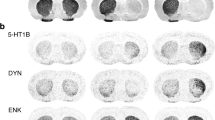Abstract
Dyskinetic movements and dystonic postures may be induced by neuroleptics in monkeys that have undergone previous neuroleptic treatment, and these motor abnormalities constitute a primate model of drug-induced extrapyramidal symptomatology. In view of previous suggestions that brain serotonergic systems may tonically inhibit dopamine neurons, the effects of several new and selective 5-HT2 receptor antagonists and 5-HT1A receptor agonists were investigated in this model. Setoperone, a dopamine D2 receptor antagonist with extremely potent 5-HT2 antagonism, caused dyskinetic movements. Although ritanserin is a potent 5-HT2 antagonist with very weak dopamine antagonist properties, this drug did not antagonize dyskinesias but induced them when administered at a high dose (30 mg/kg). Buspirone induced dyskinesias and blocked apomorphine-induced climbing, supporting prior reports that it has dopamine antagonist effects. Gepirone, a 5-HT1A agonist with less marked dopamine antagonist properties, induced dyskinesias in only one of six monkeys at 30 mg/kg and did not block haloperidol-induced dyskinesias. 8-OH-DPAT partly attenuated haloperidol-induced dyskinesias, an effect possibly attributable to its weak dopamine agonist properties. Tonic inhibition of brain extrapyramidal dopamine systems by serotonin systems does not appear to characterize neuroleptic related dyskinesias in squirrel monkeys.
Similar content being viewed by others
References
Balsara JJ, Jadhav JH, Chandorkar AG (1979) Effect of drugs influencing central serotonergic mechanisms on haloperidol-induced catalepsy. Psychopharmacology 62:67–69.
Barany S, Ingvast A, Gunne L-M (1979) Development of acute dystonia and tardive dyskinesia in cebus monkeys. Res Commun Chem Pathol Pharmacol 25:269–279.
Box GEP, Hunter WG, Hunter JS (1978) Statistics for experimenters. Wiley, New York, pp 204–205.
Costall B, Fortune DH, Naylor RJ, Marsden CD, Pycock C (1975) Serotonergic involvement with neuroleptic catalepsy. Neuropharmacology 14:859–868.
Downs DA, Harrigan SE, Heffner TG (1985) Buspirone effects in a primate model of extrapyramidal dysfunction. Soc Neurosci (Abstr) 11:426.
Finney DJ (1978) Statistical method in biological assay, 3rd edn. Macmillan, New York, pp 370–375.
Fink H, Morgenstern R, Oelssner W (1984) Clozapine—a serotonin antagonist? Pharmacol Biochem Behav 20:513–517.
Gerber R, Altar CA, Liebman JM (1988) Rotational behavior induced by 8-hydroxy-DPAT, a putative 5HT-1A agonist, in 6-hydroxydopamine-lesioned rats. Psychopharmacology 94: 178–182.
Hjorth S, Carlsson A, Lindberg P, Sanchez D, Wikstrom H, Arvidsson L-E, Hacksell U, Nilsson JLG (1982) 8-Hydroxy-2-(di-n-propylamino)tetralin, 8-OH-DPAT, a potent and selective simplified ergot congener with central 5-HT-receptor stimulating activity. J Neural Transm 55:169–188.
Hollander M, Wolfe DC (1973) Nonparametric statistical methods. Wiley, New York, pp 26–33.
Leysen JE, Gommeren W, Van Gompel P, Wynants J, Janssen PFM, Laduron PM (1985) Receptor-binding properties in vitro and in vivo of ritanserin. A very potent and long-acting serotonin-S2 antagonist. Mol Pharmacol 27:600–611.
Leysen JE, Van Gompel P, Gommeren W, Woestenborghs R, Janssen PAJ (1986) Downregulation of serotonin-S2 receptor sites in rat brain by chronic treatment with the serotonin-S2 antagonists: ritanserin and setoperone. Psychopharmacology 88:434–444.
Liebman J, Neale R (1980) Neuroleptic-induced acute dyskinesias in squirrel monkeys: correlation with propensity to cause extrapyramidal side effects. Psychopharmacology 68:25–29.
Liebman J,, Neale R (Noreika L, Braunwalder A (1981) Differential reversal of various dopamine antagonists by anticholinergics in Sidman avoidance: possible relationship to adrenergic blockade. Psychopharmacology 75:248–253.
Ludwig CL, Weinberger DR, Bruno G, Gillespie M, Bakker K, LeWitt PA, Chase TN. Buspirone, Parkinson's disease and the locus ceruleus. Clin Neuropharmacol 9:373–378
McMillen BA, Scott SM, Williams HL, Sanghera MK (1987) Effects of gepirone, an aryl-piperazine anxiolytic drug, on aggressive behavior and brain monoaminergic neurotransmission. Naunyn-Schmiedeberg's Arch Pharmacol 335:454–464.
Neale R, Gerhardt S, Liebman JM (1984) Effects of dopamine agonists, catecholamine depletors, and cholinergic and GABAergic drugs on acute dyskinesias in squirrel monkeys. Psychopharmacology 82:20–26.
Porsolt RD, Jalfre M (1981) Neuroleptic-induced acute dyskinesias in rhesus monkeys. Psychopharmacology 75:16–21.
Povlsen UJ, Noring U, Lund Laursen A, Korsgaard S, Gerlach J (1986) Effects of serotonergic and anticholinergic drugs in haloperidol-induced dystonia in Cebus monkeys. Clin Neuropharmacol 9:84–90.
Protais P, Costentin J, Schwartz JC (1976) Climbing behavior induced by apomorphine in mice — a simple test for the study of dopamine receptors in striatum. Psychopharmacology 50:1–6.
Simonovic M, Gudelsky GA, Meltzer HY (1984) Effect of 8-hydroxy-2-(di-n-propylamino)tetralin on rat prolactin secretion. J Neural Transm 59:143–149.
Waddington JL, Crow TJ (1979) Rotational responses to serotonergic and dopaminergic agonists after unilateral dihydroxytryptamine lesions of the medial forebrain bundle: co-operative interactions of serotonin and dopamine in neostriatum. Life Sci 25:1307–1314.
Waldmeier PC, Delini-Stula AA (1979) Serotonin-dopamine interactions in the nigrostriatal system. Eur J Pharmacol 55:363–373.
Weiss B, Santelli S, Lusink G (1977) Movement disorders induced in monkeys by chronic haloperidol treatment. Psychopharmacology 53:289–293.
Author information
Authors and Affiliations
Rights and permissions
About this article
Cite this article
Liebman, J.M., Gerhardt, S.C. & Gerber, R. Effects of 5-HT1A agonists and 5-HT2 antagonists on haloperidol-induced dyskinesias in squirrel monkeys: no evidence for reciprocal 5-HT-dopamine interaction. Psychopharmacology 97, 456–461 (1989). https://doi.org/10.1007/BF00439547
Received:
Accepted:
Issue Date:
DOI: https://doi.org/10.1007/BF00439547



